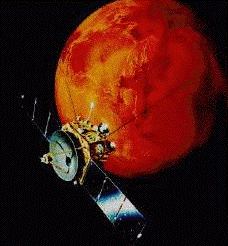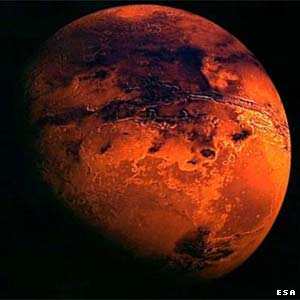MARS 

MARS
Mars is the fourth planet from the sun. The planet is one of Earth's "next-door neighbors" in space. Earth is the third planet from the sun, and Jupiter is the fifth. Like Earth, Jupiter, the sun, and the remainder of the solar system, Mars is about 4.6 billion years old.
Mars is named for the ancient Roman god of war.
Orbit and rotation
Like the other planets in the solar system, Mars travels around the sun in an elliptical (oval) orbit. But the orbit of Mars is slightly more "stretched out" than the orbits of Earth and most of the other planets. The distance from Mars to the sun can be as little as about 128,390,000 miles
Mass and density
Mars has a mass (amount of matter) of 7.08 X 1020 tons (6.42 X 1020 metric tons). The latter number would be written out as 642 followed by 18 zeroes. Earth is about 10 times as massive as Mars. Mars's density (mass divided by volume) is about 3.933 grams per cubic centimeter.
Gravitational force
Because Mars is so much smaller and less dense than Earth, the force due to gravity at the Martian surface is only about 38 percent of that on Earth. Thus, a person standing on Mars would feel as if his or her weight had decreased by 62 percent.
Physical features of Mars
Scientists do not yet know much about the interior of Mars. A good method of study would be to place a network of motion sensors called seismometers on the surface. Those instruments would measure tiny movements of the surface, and scientists would use the measurements to learn what lies beneath. Researchers commonly use this technique to study Earth's interior.
Crust
Scientists suspect that the average thickness of the Martian crust is about 30 miles (50 kilometers). Most of the northern hemisphere lies at a lower elevation than the southern hemisphere. Thus, the crust may be thinner in the north than in the south.
Core
Mars probably has a core composed of iron, nickel, and sulfur. The density of Mars gives some indication of the size of the core. Mars is much less dense than Earth.
Surface features
Mars has many of the kinds of surface features that are common on Earth. These include plains, canyons, volcanoes, valleys, gullies, and polar ice. But craters occur throughout the surface of Mars, while they are rare on Earth. In addition, fine-grained reddish dust covers almost all the Martian surface.
Volcanoes
Mars has the largest volcanoes in the solar system. The tallest one, Olympus Mons (Latin for Mount Olympus), rises 17 miles (27 kilometers) above the surrounding plains. It is about 370 miles (600 kilometers) in diameter. Three other large volcanoes, called Arsia Mons, Ascraeus Mons, and Pavonis Mons, sit atop a broad uplifted region called Tharsis.
Craters and impact basins
Many meteoroids have struck Mars over its history, producing impact craters. Impact craters are rare on Earth for two reasons: (1) Those that formed early in the planet's history have eroded away, and (2) Earth developed a dense atmosphere, preventing meteorites that could have formed craters from reaching the planet's surface.
Atmosphere
The atmosphere of Mars contains much less oxygen (O2) than that of Earth. The O2 content of the Martian atmosphere is only 0.13 percent, compared with 21 percent in Earth's atmosphere.
Pressure
At the surface of Mars, the atmospheric pressure is typically only about 0.10 pound per square inch (0.7 kilopascal).
Temperature
The atmosphere of Mars is coldest at high altitudes, from about 40 to 78 miles (65 to 125 kilometers) above the surface. At those altitudes, typical temperatures are below -200 degrees F (-130 degrees C). The temperature increases toward the surface, where daytime temperatures of -20 to -40 degrees F (-30 to -40 degrees C) are typical.
Satellites
Mars has two tiny moons, Phobos and Deimos. The American astronomer Asaph Hall discovered them in 1877 and named them for the sons of Ares. Both satellites are irregularly shaped. The largest diameter of Phobos is about 17 miles (27 kilometers); that of Deimos, about 9 miles (15 kilometers).
Possibility of life
Mars might once have harbored life, and living things might exist there even today. Mars almost certainly has three ingredients that scientists believe are necessary for life: (1) chemical elements such as carbon, hydrogen, oxygen, and nitrogen (2) a source of energy that living organisms can use, and (3) liquid water.


















